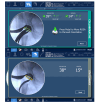Use of a fluoroscopy-based robotic-assisted total hip arthroplasty system produced greater improvements in patient-reported outcomes at one year compared to manual, fluoroscopic-assisted technique
- PMID: 38400899
- PMCID: PMC10965579
- DOI: 10.1007/s00402-024-05230-8
Use of a fluoroscopy-based robotic-assisted total hip arthroplasty system produced greater improvements in patient-reported outcomes at one year compared to manual, fluoroscopic-assisted technique
Abstract
Introduction: The adoption of new technology should be supported by improvements in patient-reported outcomes (PROMs). The purpose of this study was to assess the one-year PROMs of patients who underwent total hip arthroplasty (THA) using a novel, fluoroscopy-based, robotic-assisted (RA-THA) system when compared to a manual, fluoroscopic-assisted technique (mTHA).
Materials and methods: A review of 91 consecutive mTHA and 85 consecutive RA-THA via a direct anterior approach was conducted. All cases were performed by the same surgeon at the same institution, for a pre-operative diagnosis of osteoarthritis, avascular necrosis, or rheumatoid arthritis. Outcomes included one-year Veterans RAND-12 (VR-12) Physical/Mental, Hip Disability and Osteoarthritis Outcome (HOOS) Pain/Physical Function/Joint Replacement, and University of California Los Angeles (UCLA) Activity scores, as well as the difference between pre-operative and one-year post-operative PROMs.
Results: Patients in the RA-THA cohort had lower pre-operative HOOS-JR scores compared to patients in the mTHA cohort (37.0 vs. 43.1; p = 0.031). Cohorts experienced similar one-year post-operative VR-12, HOOS, and UCLA Activity scores. Patients in the RA-THA cohort experienced greater improvements across all pre- and post-operative HOOS scores compared to patients in the mTHA cohort: Pain (+ 54.7 vs. +42.1; p = 0.009), Physical Function (-41.6 vs. -28.7; p = 0.007), and Joint Replacement (+ 46.6 vs. +33.0; p = 0.002). These differences exceeded minimum clinically important difference (MCID).
Conclusions: Both manual and robotic cohorts experienced benefit from THA at one-year post-operative. Importantly, the use of a novel, fluoroscopy-based robotic assistance system for primary THA resulted in greater improvements in PROMs at one-year relative to manual technique.
Keywords: Arthroplasty; Hip; Patient-reported outcome measures; Robotic-assisted surgery.
© 2024. The Author(s).
Conflict of interest statement
• Authors G.B.J.B., C.B.O., C.J.H., and L.S.SG. declare that they have no relevant competing interests. Authors C.A.D. and A.F.K. have the below disclosures:
•C.A.D.
•Royalties: DePuySynthes, Mizuho-OSI.
•Speakers bureau: DePuySynthes, Medtronic.
•Stock or stock options: JointPoint, JointVue.
•A.F.K.
•Royalties: Innomed, ZimmerBiomet.
•Speakers bureau: ZimmerBiomet, Johnson and Johnson, BodyCad.
•Paid consultant: ZimmerBiomet, Johnson and Johnson, BodyCad, United Ortho, Orthopedic Development.
•Stock or stock options: ZimmerBiomet, Johnson and Johnson, Procter and Gamble.
•Research support: Signature Orthopedics.
Figures


Similar articles
-
Use of a fluoroscopy-based robotic-assisted total hip arthroplasty system resulted in greater improvements in hip-specific outcome measures at one-year compared to a CT-based robotic-assisted system.Int J Med Robot. 2024 Jun;20(3):e2650. doi: 10.1002/rcs.2650. Int J Med Robot. 2024. PMID: 38856120
-
Improved Functional Outcomes with Robotic Compared with Manual Total Hip Arthroplasty.Surg Technol Int. 2016 Oct 26;29:303-308. Surg Technol Int. 2016. PMID: 27728953
-
Improved short-term outcomes for a novel, fluoroscopy-based robotic-assisted total hip arthroplasty system compared to manual technique with fluoroscopic assistance.Arch Orthop Trauma Surg. 2024 Jan;144(1):501-508. doi: 10.1007/s00402-023-05061-z. Epub 2023 Sep 23. Arch Orthop Trauma Surg. 2024. PMID: 37740783
-
Robotic-assisted total hip arthroplasty utilizing a fluoroscopy-guided system resulted in improved intra-operative efficiency relative to a computerized tomography-based platform.J Robot Surg. 2023 Dec;17(6):2841-2847. doi: 10.1007/s11701-023-01723-7. Epub 2023 Sep 28. J Robot Surg. 2023. PMID: 37770721 Review.
-
Patient-reported outcome differences for navigated and robot-assisted total hip arthroplasty frequently do not achieve clinically important differences: a systematic review.Hip Int. 2024 Sep;34(5):578-587. doi: 10.1177/11207000241241797. Epub 2024 Apr 2. Hip Int. 2024. PMID: 38566302
Cited by
-
MAKO robotic-assisted compared to conventional total hip arthroplasty for hip osteoarthritis: a systematic review and meta-analysis.J Orthop Surg Res. 2025 May 16;20(1):466. doi: 10.1186/s13018-025-05866-1. J Orthop Surg Res. 2025. PMID: 40380310 Free PMC article.
References
Publication types
MeSH terms
LinkOut - more resources
Full Text Sources
Medical

